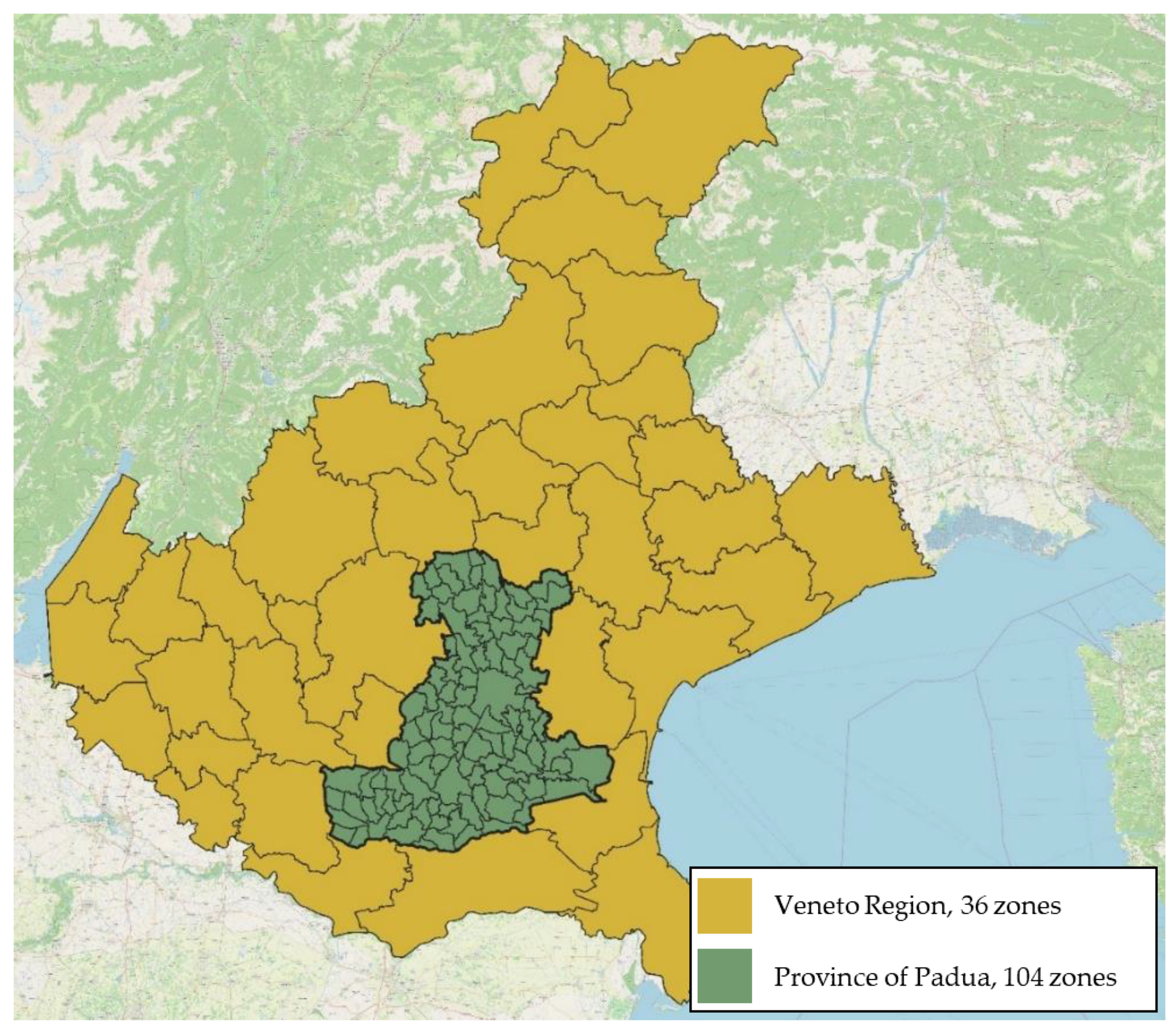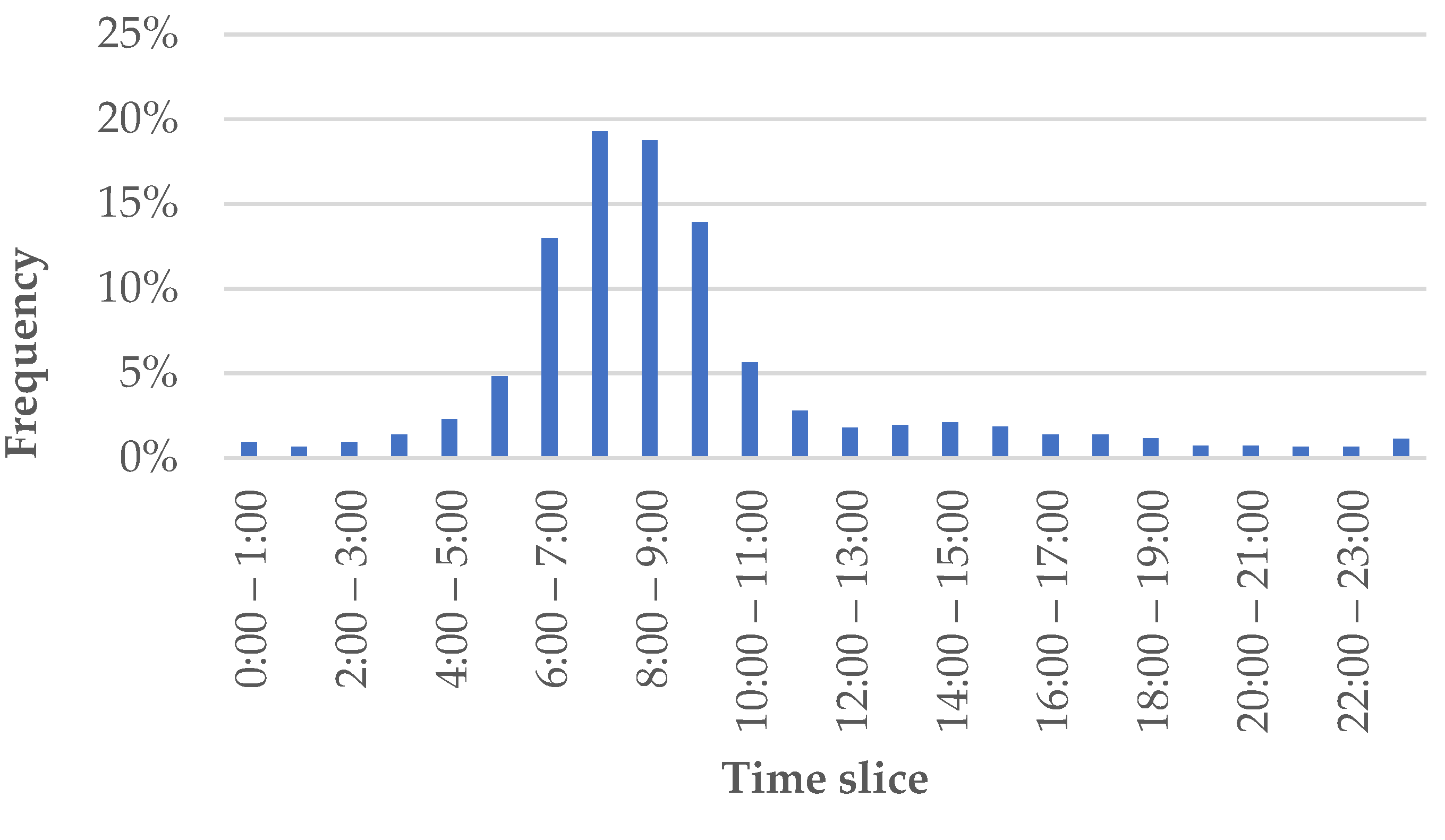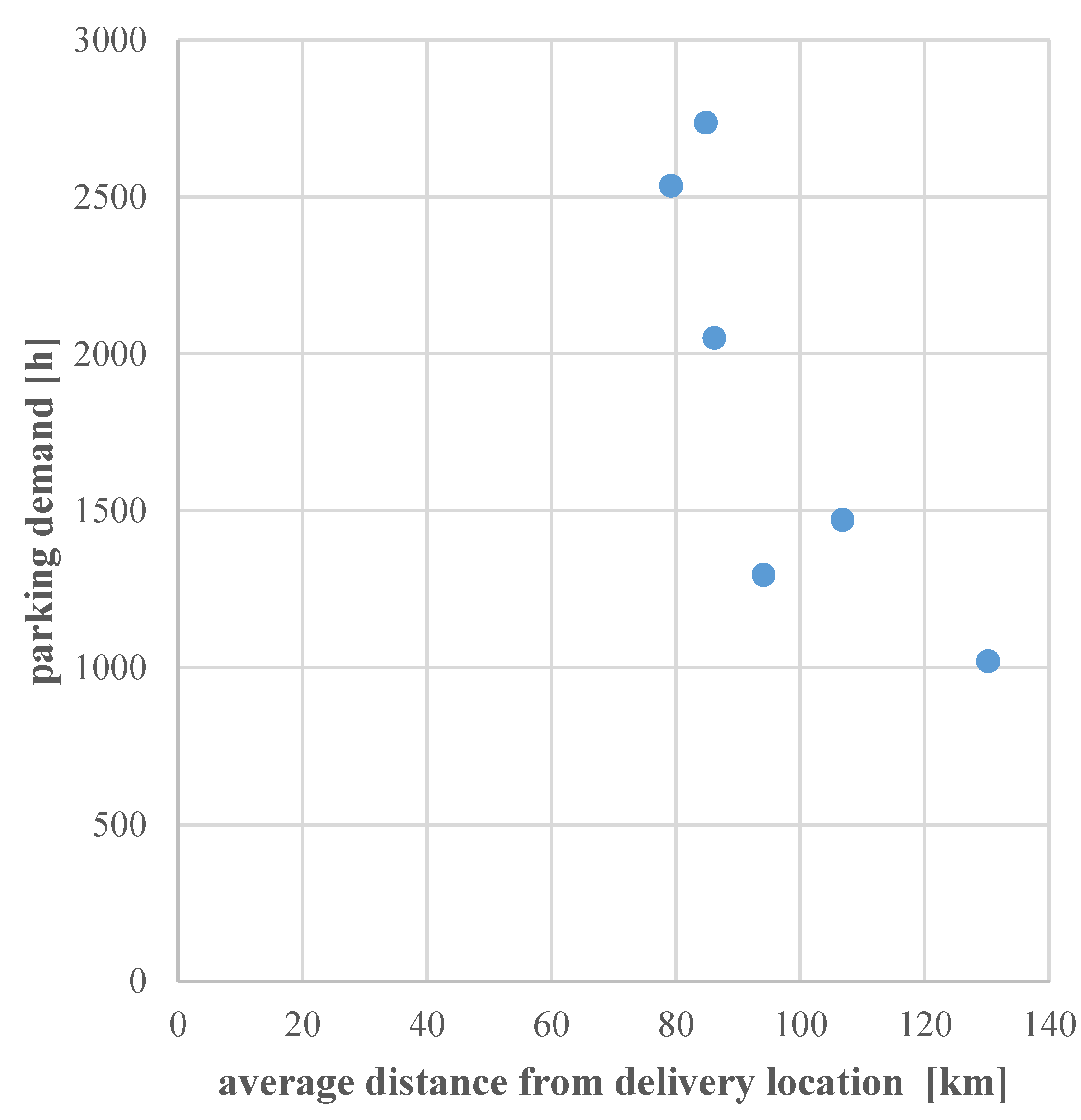Forecasting Delivery Pattern through Floating Car Data: Empirical Evidence
Abstract
1. Introduction
2. Background
3. Model Formulation
- To is the total number of tours with n trips departing from zone o at time interval t;
- p[t/o] is the probability/share of starting tours at time interval t starting from zone o;
- p[n/to] is the probability of tours with n trips, conditioned to start at time interval t from zone o;
- p[v/nto] is the probability that the tour is performed by a vehicle of type v, conditioned to perform n trips starting at time interval t from zone o.
4. Application
4.1. Study Area
4.2. Data Analysis
4.3. Estimation Results
- if it is considered only a value for time t (i.e., day), then p[t/o] = 1;
- if considered only a type of vehicle (i.e., light goods vehicle), then p[v/nto] = 1.
- ADD is the number of employees at the warehouse in the origin zone o;
- POP is the number of inhabitants in the origin zone o;
- KM is the average distance to travel from the origin zone o to all other zones within the study area (in kilometers);
- is the alternative specific attributes (ASA) for the alternative n.
4.4. Validation Results
5. Conclusions
Author Contributions
Funding
Institutional Review Board Statement
Informed Consent Statement
Data Availability Statement
Acknowledgments
Conflicts of Interest
References
- Nuzzolo, A.; Comi, A. Urban Freight Demand Forecasting: A Mixed Quantity/Delivery/Vehicle-Based Model. Transp. Res. Part E Logist. Transp. Rev. 2014, 65, 84–98. [Google Scholar] [CrossRef]
- Kitamura, R.; Fujii, S.; Pas, E.I. Time-Use Data, Analysis and Modeling: Toward the next Generation of Transportation Planning Methodologies. Transp. Policy 1997, 4, 225–235. [Google Scholar] [CrossRef]
- Dodson, J.; Burke, M.; Evans, R.; Gleeson, B.; Sipe, N. Travel Behavior Patterns of Different Socially Disadvantaged Groups: Analysis of Household Travel Survey Data for a Dispersed Metropolitan Area. Transp. Res. Rec. 2010, 2163, 24–31. [Google Scholar] [CrossRef]
- Ezquerro, S.; Romero, J.P.; Moura, J.L.; Benavente, J.; Ibeas, Á. Minimizing the Impact of Large Freight Vehicles in the City: A Multicriteria Vision for Route Planning and Type of Vehicles. Available online: https://www.hindawi.com/journals/jat/2018/1732091/ (accessed on 1 December 2020). [CrossRef]
- Schuessler, N.; Axhausen, K.W. Processing Raw Data from Global Positioning Systems without Additional Information. Transp. Res. Rec. 2009. [Google Scholar] [CrossRef]
- Ayazi, E.; Sheikholeslami, A. A Data Mining Approach on Lorry Drivers Overloading in Tehran Urban Roads. Available online: https://www.hindawi.com/journals/jat/2020/6895407/ (accessed on 1 December 2020).
- Nuzzolo, A.; Comi, A. Tactical and Operational City Logistics: Freight Vehicle Flow Modelling. In Freight Transport Modelling; Ben-Akiva, M., Meersman, H., Van de Voorde, E., Eds.; Emerald Group Publishing Limited: Bingley, UK, 2013; pp. 433–451. [Google Scholar] [CrossRef]
- Nuzzolo, A.; Comi, A.; Polimeni, A. Urban Freight Vehicle Flows: An Analysis of Freight Delivery Patterns through Floating Car Data. Transp. Res. Procedia 2020, 47, 409–416. [Google Scholar] [CrossRef]
- Comi, A.; Nuzzolo, A.; Polimeni, A. Aggregate Delivery Tour Modeling through AVM Data: Experimental Evidence for Light Goods Vehicles. Transp. Lett. 2021, 13, 201–208. [Google Scholar] [CrossRef]
- Russo, F.; Comi, A. A Modelling System to Simulate Goods Movements at an Urban Scale. Transportation 2010, 37, 987–1009. [Google Scholar] [CrossRef]
- Russo, F.; Vitetta, A.; Polimeni, A. From Single Path to Vehicle Routing: The Retailer Delivery Approach. Procedia-Soc. Behav. Sci. 2010, 2, 6378–6386. [Google Scholar] [CrossRef][Green Version]
- Holguín-Veras, J.; Sánchez-Díaz, I.; Lawson, C.T.; Jaller, M.; Campbell, S.; Levinson, H.S.; Shin, H.-S. Transferability of Freight Trip Generation Models. Transp. Res. Rec. 2013, 2379, 1–8. [Google Scholar] [CrossRef]
- Sánchez-Díaz, I. Modeling Urban Freight Generation: A Study of Commercial Establishments’ Freight Needs. Transp. Res. Part Policy Pract. 2017, 102, 3–17. [Google Scholar] [CrossRef]
- Hu, W.; Dong, J.; Hwang, B.; Ren, R.; Chen, Z. A Scientometrics Review on City Logistics Literature: Research Trends, Advanced Theory and Practice. Sustainability 2019, 11, 2724. [Google Scholar] [CrossRef]
- Ambrosini, C.; Routhier, J.-L. Objectives, Methods and Results of Surveys Carried out in the Field of Urban Freight Transport: An International Comparison. Transp. Rev. 2004, 24, 57–77. [Google Scholar] [CrossRef]
- Allen, J.; Browne, M.; Cherrett, T. Survey Techniques in Urban Freight Transport Studies. Transp. Rev. 2012, 32, 287–311. [Google Scholar] [CrossRef]
- Hunt, J.D.; Stefan, K.J. Tour-Based Microsimulation of Urban Commercial Movements. Transp. Res. Part B Methodol. 2007, 41, 981–1013. [Google Scholar] [CrossRef]
- Nuzzolo, A.; Comi, A.; Ibeas, A.; Moura, J.L. Urban Freight Transport and City Logistics Policies: Indications from Rome, Barcelona, and Santander. Int. J. Sustain. Transp. 2016, 10, 552–566. [Google Scholar] [CrossRef]
- Thoen, S.; Tavasszy, L.; de Bok, M.; Correia, G.; van Duin, R. Descriptive Modeling of Freight Tour Formation: A Shipment-Based Approach. Transp. Res. Part E Logist. Transp. Rev. 2020, 140, 101989. [Google Scholar] [CrossRef]
- Polimeni, A.; Russo, F.; Vitetta, A. Demand and Routing Models for Urban Goods Movement Simulation. Eur. Transp. 2010, 46, 3–23. [Google Scholar]
- Musolino, G.; Rindone, C.; Polimeni, A.; Vitetta, A. Planning Urban Distribution Center Location with Variable Restocking Demand Scenarios: General Methodology and Testing in a Medium-Size Town. Transp. Policy 2019, 80, 157–166. [Google Scholar] [CrossRef]
- Gómez-Marín, C.G.; Serna-Urán, C.A.; Arango-Serna, M.D.; Comi, A. Microsimulation-Based Collaboration Model for Urban Freight Transport. IEEE Access 2020, 8, 182853–182867. [Google Scholar] [CrossRef]
- Wisetjindawat, W.; Sano, K.; Matsumoto, S.; Raothanachonkun, P. Microsimulation Model for Modeling Freight Agents Interactions in Urban Freight Movement. In Proceedings of the 86th Annual Meeting of the Transportation Research Board, Washington, DC, USA, 21–25 January 2007. [Google Scholar]
- Ruan, M.; Lin, J.; Kawamura, K. Modeling Urban Commercial Vehicle Daily Tour Chaining. Transp. Res. Part E Logist. Transp. Rev. 2012, 48, 1169–1184. [Google Scholar] [CrossRef]
- Outwater, M.; Smith, C.; Wies, K.; Yoder, S.; Sana, B.; Chen, J. Tour Based and Supply Chain Modeling for Freight: Integrated Model Demonstration in Chicago. Transp. Lett. 2013, 5, 55–66. [Google Scholar] [CrossRef]
- Wang, Q.; Holguín-Veras, J. Tour-Based Entropy Maximization Formulations of Urban Freight Demand. In Proceedings of the 88th Annual Meeting of the Transportation Research Board, Washington, DC, USA, 11–15 January 2009.You, S.I.; Ritchie, S.G. Tour-Based Truck Demand Modeling with Entropy Maximization Using GPS Data. J. Adv. Transp. 2019, 2019, e5021026. [Google Scholar] [CrossRef]
- Gonzalez-Calderon, C.A.; Holguín-Veras, J. Entropy-Based Freight Tour Synthesis and the Role of Traffic Count Sampling. Transp. Res. Part E Logist. Transp. Rev. 2019, 121, 63–83. [Google Scholar] [CrossRef]
- Zhang, Z.; He, Q.; Tong, H.; Gou, J.; Li, X. Spatial-Temporal Traffic Flow Pattern Identification and Anomaly Detection with Dictionary-Based Compression Theory in a Large-Scale Urban Network. Transp. Res. Part C Emerg. Technol. 2016, 71, 284–302. [Google Scholar] [CrossRef]
- Chankaew, N.; Sumalee, A.; Treerapot, S.; Threepak, T.; Ho, H.W.; Lam, W.H.K. Freight Traffic Analytics from National Truck GPS Data in Thailand. Transp. Res. Procedia 2018, 34, 123–130. [Google Scholar] [CrossRef]
- Siripirote, T.; Sumalee, A.; Ho, H.W. Statistical Estimation of Freight Activity Analytics from Global Positioning System Data of Trucks. Transp. Res. Part E Logist. Transp. Rev. 2020, 140, 101986. [Google Scholar] [CrossRef]
- Camargo, P.; Hong, S.; Livshits, V. Expanding the Uses of Truck GPS Data in Freight Modeling and Planning Activities. Transp. Res. Rec. 2017, 2646, 68–76. [Google Scholar] [CrossRef]
- Karam, A.; Illemann, T.M.; Reinau, K.H.; Vuk, G.; Hansen, C.O. Towards Deriving Freight Traffic Measures from Truck Movement Data for State Road Planning: A Proposed System Framework. ISPRS Int. J. Geo-Inf. 2020, 9, 606. [Google Scholar] [CrossRef]
- Romano Alho, A.; Sakai, T.; Chua, M.H.; Jeong, K.; Jing, P.; Ben-Akiva, M. Exploring Algorithms for Revealing Freight Vehicle Tours, Tour-Types, and Tour-Chain-Types from GPS Vehicle Traces and Stop Activity Data. J. Big Data Anal. Transp. 2019, 1, 175–190. [Google Scholar] [CrossRef]
- Holguín-Veras, J.; Encarnación, T.; Pérez-Guzmán, S.; Yang, X. Mechanistic Identification of Freight Activity Stops from Global Positioning System Data. Transp. Res. Rec. 2020, 2674, 235–246. [Google Scholar] [CrossRef]
- Du, J.; Aultman-Hall, L. Increasing the Accuracy of Trip Rate Information from Passive Multi-Day GPS Travel Datasets: Automatic Trip End Identification Issues. Transp. Res. Part Policy Pract. 2007, 41, 220–232. [Google Scholar] [CrossRef]
- Wang, B.; Gao, L.; Juan, Z. A Trip Detection Model for Individual Smartphone-Based GPS Records with a Novel Evaluation Method. Adv. Mech. Eng. 2017, 9. [Google Scholar] [CrossRef]
- Karam, A.; Illemann, T.M.; Reinau, K.H. GPS-Derived Measures of Freight Trucks for Rest Areas: A Case-Study Based Analysis. In Proceedings of the 2020 IEEE International Conference on Industrial Engineering and Engineering Management (IEEM), Marina Bay Sands, Singapore, 14–17 December 2020; pp. 939–943. [Google Scholar] [CrossRef]
- Joubert, J.W.; Axhausen, K.W. Inferring Commercial Vehicle Activities in Gauteng, South Africa. J. Transp. Geogr. 2011, 19, 115–124. [Google Scholar] [CrossRef]
- Comendador, J.; López-Lambas, M.E.; Monzón, A. A GPS Analysis for Urban Freight Distribution. Procedia-Soc. Behav. Sci. 2012, 39, 521–533. [Google Scholar] [CrossRef]
- Yang, X.; Sun, Z.; Ban, X.J.; Holguín-Veras, J. Urban Freight Delivery Stop Identification with GPS Data. Transp. Res. Rec. 2014. [Google Scholar] [CrossRef]
- Greaves, S.P.; Figliozzi, M.A. Collecting Commercial Vehicle Tour Data with Passive Global Positioning System Technology: Issues and Potential Applications. Transp. Res. Rec. 2008. [Google Scholar] [CrossRef]
- Rathore, M.M.; Ahmad, A.; Paul, A.; Rho, S. Urban Planning and Building Smart Cities Based on the Internet of Things Using Big Data Analytics. Comput. Netw. 2016, 101, 63–80. [Google Scholar] [CrossRef]
- Egu, O.; Bonnel, P. How Comparable Are Origin-Destination Matrices Estimated from Automatic Fare Collection, Origin-Destination Surveys and Household Travel Survey? An Empirical Investigation in Lyon. Transp. Res. Part Policy Pract. 2020, 138, 267–282. [Google Scholar] [CrossRef]
- Ben-Akiva, M.; Lerman, S.R. Discrete Choice Analysis: Theory and Application to Travel Demand; Transportation Studies; MIT Press: Cambridge, MA, USA, 1985. [Google Scholar]
- Holguín-Veras, J.; Jaller, M.; Sanchez-Diaz, I.; Wojtowicz, J.; Campbell, S.; Levinson, H.; Lawson, C.; Powers, E.L.; Tavasszy, L. Freight Trip Generation and Land Use; Transportation Research Board, National Academies of Sciences, Engineering, and Medicine, Ed.; The National Academies Press: Washington, DC, USA, 2012. [Google Scholar] [CrossRef]
- Holguín-Veras, J.; Campbell, S.; González-Calderón, C.A.; Ramírez-Ríos, D.; Kalahasthi, L.; Aros-Vera, F.; Browne, M.; Sanchez-Diaz, I. Importance and Potential Applications of Freight and Service Activity Models. In City Logistics 1; John Wiley & Sons, Ltd.: Hoboken, NJ, USA, 2018; pp. 45–63. [Google Scholar] [CrossRef]






| Parameter | Value | Parameter | Value | Parameter | Value |
|---|---|---|---|---|---|
| β2n | 6.847 × 10−2 | β3n | 2.576 × 10−2 | β4n | 9.717 × 10−2 |
| β2AD | 1.004 × 10−4 | β3AD | 3.746 × 10−5 | β4AD | 8.650 × 10−5 |
| β2POP | −2.656 × 10−6 | β3POP | −3.046 × 10−6 | β4POP | −2.668 × 10−6 |
| β2km | 1.179 × 10−4 | β3km | 4.060 × 10−3 | β4km | 1.623 × 10−2 |
| R2 = 0.99 | |||||
| Stop Number Class | Observed Tours | Modelled Tours | Coincidence Ratio |
|---|---|---|---|
| 1 | 1234 | 1391 | 13% |
| 2 | 1734 | 1685 | −3% |
| 3 | 1377 | 1622 | 18% |
| 4 | 4043 | 3690 | −9% |
| Total/Average | 8388 | 8388 | 5% |
| Verona | Rovigo | Venice | Treviso | Vicenza | Belluno | |
|---|---|---|---|---|---|---|
| Attributes | ||||||
| Wholesale employees | 9463 | 2112 | 3727 | 6597 | 7675 | 1270 |
| Population | 324,079 | 142,400 | 298,938 | 289,914 | 349,590 | 74,206 |
| Average distance [km] | 106.84 | 94.1 | 84.9 | 86.2 | 79.3 | 130.2 |
| Tours | ||||||
| Tours per day (observed) | 1083 | 976 | 2167 | 1558 | 1957 | 744 |
| Tours/wholesale employees-day | 0.114 | 0.462 | 0.581 | 0.236 | 0.255 | 0.586 |
| Tours/population-day | 0.003 | 0.007 | 0.007 | 0.005 | 0.006 | 0.010 |
| Tours/average distance | 10.14 | 10.37 | 25.54 | 18.07 | 24.69 | 5.71 |
| Stop number class | ||||||
| Class 1 | 11.13% | 14.00% | 19.62% | 15.66% | 17.78% | 8.46% |
| Class 2 | 13.19% | 12.84% | 13.95% | 15.21% | 16.42% | 8.58% |
| Class 3 | 9.36% | 14.77% | 13.14% | 12.07% | 11.57% | 12.32% |
| Class 4 | 66.32% | 58.39% | 53.30% | 57.07% | 54.23% | 70.65% |
| Stop Number Class | Average Total Stop Time [Minutes] | Average Tour Time [Minutes] |
|---|---|---|
| Class 1 | 12.40 | 247.09 |
| Class 2 | 114.80 | 255.29 |
| Class 3 | 91.48 | 292.11 |
| Class 4 | 84.95 | 280.54 |
| Verona | Rovigo | Venice | Treviso | Vicenza | Belluno | |
|---|---|---|---|---|---|---|
| parking demand (tours produced) | ||||||
| Class 1 | 1495 | 1694 | 5272 | 3025 | 4315 | 780 |
| Class 2 | 16,399 | 14,387 | 34,704 | 27,204 | 36,890 | 7328 |
| Class 3 | 9273 | 13,187 | 26,048 | 17,203 | 20,713 | 8385 |
| Class 4 | 61,015 | 48,412 | 98,118 | 75,533 | 90,156 | 44,653 |
| Total [minutes] | 88,182 | 77,680 | 164,142 | 122,966 | 152,074 | 61,147 |
| Total [h] | 1469.7 | 1294.7 | 2735.7 | 2049.4 | 2534.6 | 1019.1 |
Publisher’s Note: MDPI stays neutral with regard to jurisdictional claims in published maps and institutional affiliations. |
© 2021 by the authors. Licensee MDPI, Basel, Switzerland. This article is an open access article distributed under the terms and conditions of the Creative Commons Attribution (CC BY) license (https://creativecommons.org/licenses/by/4.0/).
Share and Cite
Comi, A.; Polimeni, A. Forecasting Delivery Pattern through Floating Car Data: Empirical Evidence. Future Transp. 2021, 1, 707-719. https://doi.org/10.3390/futuretransp1030038
Comi A, Polimeni A. Forecasting Delivery Pattern through Floating Car Data: Empirical Evidence. Future Transportation. 2021; 1(3):707-719. https://doi.org/10.3390/futuretransp1030038
Chicago/Turabian StyleComi, Antonio, and Antonio Polimeni. 2021. "Forecasting Delivery Pattern through Floating Car Data: Empirical Evidence" Future Transportation 1, no. 3: 707-719. https://doi.org/10.3390/futuretransp1030038
APA StyleComi, A., & Polimeni, A. (2021). Forecasting Delivery Pattern through Floating Car Data: Empirical Evidence. Future Transportation, 1(3), 707-719. https://doi.org/10.3390/futuretransp1030038







